When someone loses a limb, it can feel like life has been turned upside down. There’s a lot to process — emotionally and physically. But while you’re healing, there’s something very important you can do that will help make everything that comes after much easier: start strengthening your residual limb.
Before a prosthetic can feel comfortable, the body needs to be ready. That means your limb must be shaped well, your skin must be healthy, and the muscles around the area need to be strong and active. Without that, the prosthetic can feel heavy, unstable, or even painful to wear. But if your limb is prepared and strong, using a prosthetic becomes smoother, more natural, and even empowering.
This part of recovery — strengthening the limb before fitting — is often overlooked. People are eager to move on, to walk or work or get back to the life they had. But the truth is, if you take time now to prepare your body, you’ll recover faster, and your prosthetic will work better.
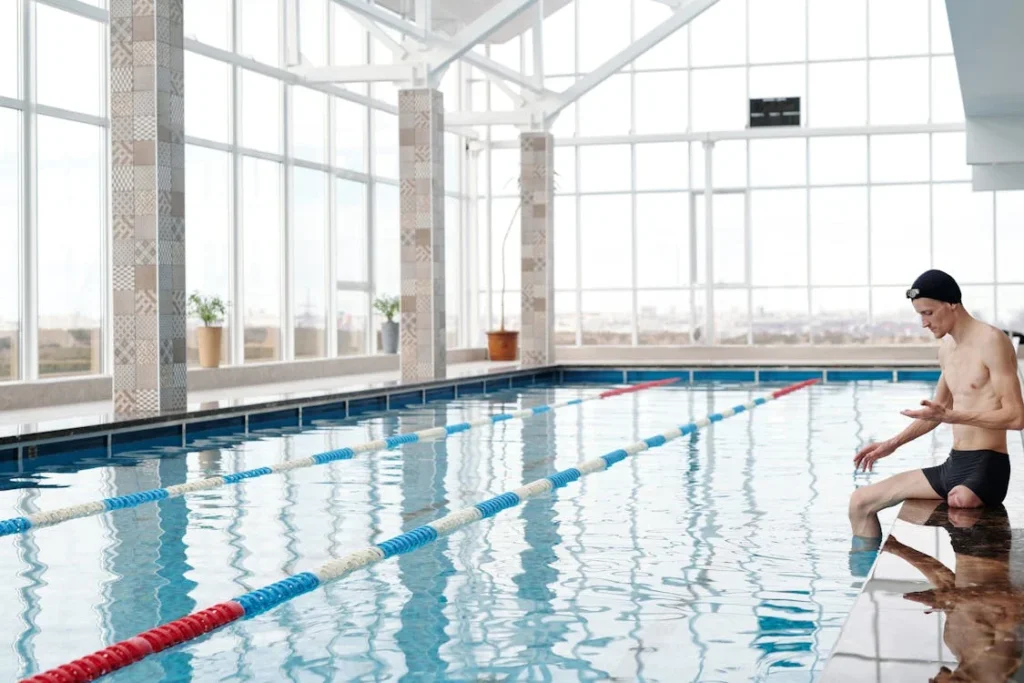
Understanding the Residual Limb After Surgery
What Happens to Your Muscles After Amputation
After surgery, your body begins a process of healing. But while the wound is healing on the outside, something else is happening inside — your muscles, nerves, and tissues are adjusting to a new structure. Muscles that once controlled your missing limb now have no job to do.
Without movement or therapy, they can get weaker. They may shrink or lose flexibility. Over time, if you don’t use them, they can even stop working the way they should.
That’s why starting early — even with small movements — is key. When you move your muscles, even gently, you’re telling your body, “Hey, I still need these.” That signal keeps the muscles active, prevents stiffness, and helps your limb maintain a healthy shape.
A well-shaped limb is important for another reason. If the limb is swollen, soft, or has uneven tissue, it becomes harder to fit into a prosthetic socket.
This can lead to pressure points or rubbing, which might cause pain or skin breakdown later. By using your muscles and managing swelling, your limb becomes firmer, more even, and better suited for a comfortable fit.
The Role of Muscle Memory and Control
Strengthening your residual limb isn’t just about building muscle — it’s also about retraining your brain. After amputation, your brain still sends signals to the missing part of your body.
This is why many people experience phantom sensations or even pain. But with movement and therapy, you can help your brain understand the new shape of your body and build new connections to the muscles that are still there.
When you practice moving the residual limb — even without weight or resistance — you’re rebuilding control. This makes it much easier to use a prosthetic later, because your brain and body already know how to work together.
This kind of training is sometimes called “neuromuscular re-education,” but don’t let the word scare you. It simply means doing small, repeated movements that teach your nerves and muscles to work in sync again.
Think of it like tuning an instrument — small adjustments over time lead to a smoother performance.
Why Waiting to Strengthen Can Make Things Harder
It’s natural to want to rest after surgery. Your body has been through a lot, and rest is part of healing. But resting too long without movement can slow your recovery.
Muscles lose tone, joints stiffen, and it becomes harder to do everyday things — like getting out of bed, sitting upright, or keeping your balance.
If you wait until you get a prosthetic to start moving, you may find it frustrating or uncomfortable. It’s like trying to run before you’ve learned to walk.
That’s why early movement matters so much. Even if it’s just a few minutes a day, gentle strengthening exercises can prevent setbacks later.
Your therapist will guide you on what’s safe and when to begin. The key is to start where you are — no matter how small — and build from there. You don’t need to push hard or strain. You just need to stay consistent.
Building Strength in More Than One Way
There’s more to strengthening your residual limb than doing exercises. It’s also about posture, breathing, and even your mindset. Sitting or lying in the right position helps your muscles stay stretched and ready.
Deep breathing improves oxygen flow to the tissues. And believing in your own progress — even if it’s slow — keeps you motivated to keep going.
Some people use soft resistance bands or light weights later in their recovery. Others begin with body weight movements like lifting the limb while lying down or tightening their muscles while staying still.
Both are good. What matters most is that the movement feels safe and controlled.
Over time, your residual limb will become more stable, more defined, and more responsive. That’s when you’ll start noticing the benefits — in balance, in comfort, and in how your body feels overall.
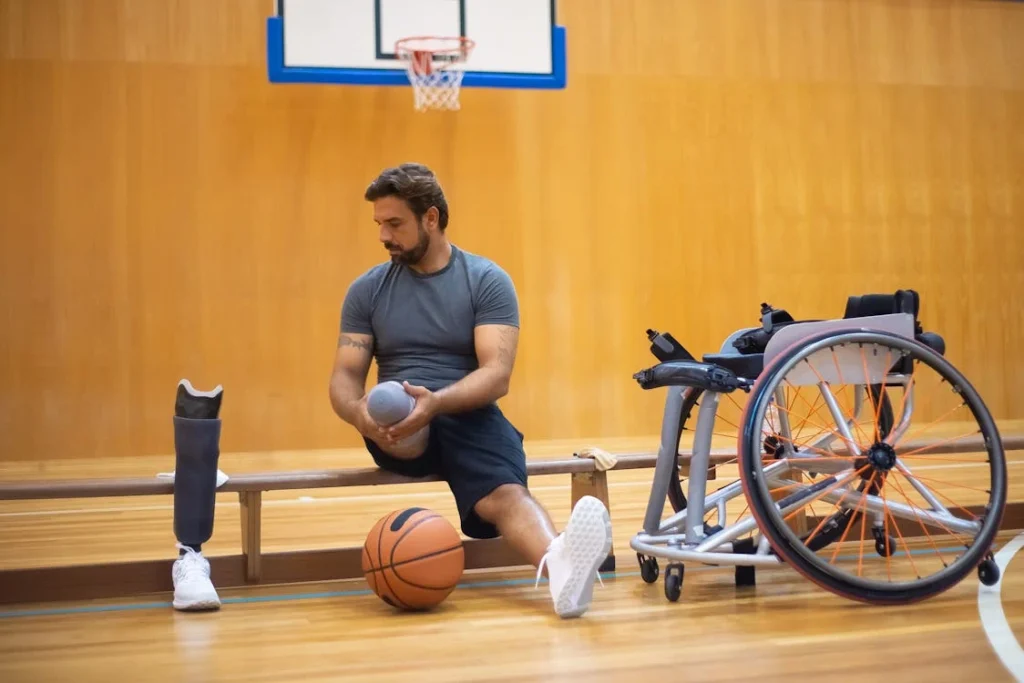
How to Safely Strengthen Your Residual Limb
Starting Slow: Movement Without Resistance
In the first stage of recovery, movement doesn’t have to mean exercise in the way you may imagine. It starts with something much simpler — reconnecting with your limb.
This means waking up the muscles gently and reminding them to stay active. You might begin by simply tightening and relaxing the muscles around the limb. This is sometimes called muscle setting.
You could lie on your back, take a deep breath, and gently squeeze the muscles in your residual limb. Hold for a few seconds, then release.
You might not see a lot of movement at first, but that’s okay. The goal is to send a message from your brain to your body — to reactivate that connection.
As you get more comfortable, you can try lifting the limb slightly while lying down, just using your own body weight. This helps develop control without strain. It also teaches you where your strength currently is — and where you can build more.
Even just changing positions throughout the day helps. Sitting upright, shifting your weight from side to side, or adjusting how your limb rests on a cushion — all of this encourages circulation, activates muscle fibers, and prevents stiffness.
Bringing in the Core and Upper Body
You might be focusing on your residual limb, but here’s a key idea: your whole body is part of the process. When one part of your body changes, the rest has to adapt.
So, strengthening your core — the muscles in your stomach, back, and hips — plays a big role in helping your limb recover.
Why? Because your core helps you balance. It supports your posture. It stabilizes you when you sit, stand, or move. If your core is weak, your limb has to work harder. That can lead to poor form or even injury.
You can begin working your core by tightening your stomach muscles while sitting or lying flat. Focus on breathing in and out slowly.
Then try reaching forward with your arms or leaning slightly to one side and back — small movements that engage your center without overdoing it.
If your upper limb is intact, gentle arm movements help too. Reaching across your body, pressing your hands together, or lifting a small object helps activate shoulder and back muscles.
This also improves coordination, which comes in handy later when you’re learning to balance with a prosthetic.
Staying Consistent Even on Low-Energy Days
Recovery can be unpredictable. Some days, you’ll feel motivated. Other days, just getting out of bed may feel like a big task. That’s okay. What matters most isn’t doing everything perfectly — it’s doing something regularly.
Consistency is key. Even if you don’t do a full therapy routine, small movements still count. Try doing a few limb lifts before bed. Or sit upright with good posture while watching TV. These actions seem small, but over time, they add up.
One way to stay motivated is to track your progress. Keep a small journal or notes in your phone. Write down what you did each day, even if it was just a few minutes of movement. Looking back and seeing how far you’ve come can lift your spirits on hard days.
You can also involve a family member or caregiver. Having someone check in, cheer you on, or do the routine with you adds accountability and support. It turns therapy into a shared goal — not just something you do alone.
Some people find motivation by setting mini-goals. Maybe you want to sit without leaning for a full minute. Or lift your limb five times in a row. These little wins matter more than you think. They give your brain a signal: I’m making progress. I’m getting stronger.
Learning to Listen to Your Body
Strengthening doesn’t mean pushing until it hurts. In fact, pain is your body’s way of asking you to pause. It’s important to know the difference between normal soreness and something that’s not right.
A little discomfort is okay, especially as you begin using muscles you haven’t used in a while. But sharp pain, swelling, or intense fatigue means it’s time to rest or check in with your therapist.
Think of therapy as a conversation between your body and your mind. Some days it’ll say, “Let’s try more.” Other days, it’ll whisper, “Let’s take it slow.” Listening to those messages helps you recover smarter, not just faster.
Therapists can also help adjust movements based on what your body needs. They may suggest gentle stretches for tight areas, posture adjustments for balance, or different angles for lifting your limb. These small tweaks can make a huge difference in comfort and progress.

How Strength Supports a Better Prosthetic Fit
What Your Limb Needs to Handle During Fitting
When the time comes to get your prosthetic, your limb goes through a lot. You’ll be fitted with a socket, which is the part of the prosthetic that connects your body to the device.
This socket needs to fit snugly and stay in place as you move. If your limb isn’t strong or stable, it becomes harder to get a secure fit. And that can cause problems down the line — like pressure points, rubbing, or even open wounds.
A strong, well-shaped limb is more predictable. The muscles hold their shape. The skin is firm and healthy. And the tissue responds better to pressure.
That means your prosthetist has a much easier time designing a socket that works for you. There’s less guessing, fewer adjustments, and a better experience overall.
If your limb is weak or still swollen, the socket might feel too tight one day and too loose the next. It may slide, pinch, or cause pain.
This makes walking or using the prosthetic frustrating — and in some cases, people stop wearing it altogether. That’s why the work you do before the fitting is just as important as what happens after.
Muscle Strength Helps With Control and Movement
Prosthetics are tools — but you are the engine. Your body has to drive the movement. If the muscles in your residual limb are strong, you’ll find it much easier to control your prosthetic.
This is especially true for upper limb prosthetics, where muscle signals are used to open and close fingers, rotate the wrist, or grip objects.
Even with passive or body-powered prosthetics, your muscles need to be active. For example, if your limb is too weak to push against the socket, you might lose contact — which throws off your balance or causes the prosthetic to shift.
When your muscles are engaged and strong, every step, every reach, every grip becomes easier. You’re not fighting against the device. You’re working with it.
People often say they feel more connected to their prosthetic when they’re strong. That sense of connection doesn’t come from technology alone. It comes from how well your body works with the device — and that begins with preparation.
Strong Core = Better Balance and Less Fatigue
Here’s something many people don’t expect: using a prosthetic takes energy. In fact, at first, it can be quite tiring. That’s because your body is adjusting to a new way of moving.
Muscles you didn’t use much before are suddenly active. You might take shorter steps, walk more carefully, or use your arms to steady yourself.
When your core is strong, your whole body works more efficiently. You don’t tire out as quickly. You’re able to stand longer, move more naturally, and stay upright with less effort. This also helps protect your sound limb (the one that wasn’t affected by the amputation), which often takes on more weight and pressure during movement.
A strong core also helps with alignment. This means your spine stays straight, your shoulders are level, and your hips don’t dip or twist. Good alignment reduces strain on your back, knees, and joints — and that prevents future pain or injury.
The best part? All this strength makes the prosthetic feel like part of you — not a separate object. It moves when you move. It responds when you shift. And that’s when the real transformation begins.
Being Mentally Ready Helps Too
Physical strength matters. But mental strength is just as important. When you’ve taken time to prepare your body, something else happens: you trust yourself more.
You know how your limb responds. You know how to adjust your posture. You’ve learned how to breathe through frustration and stay consistent.
This mental readiness shows during the fitting. You’re more patient with the process. You’re better at describing how the prosthetic feels.
You’re more confident trying new movements. That mindset — calm, focused, engaged — makes you a better partner in your own recovery.
And that’s something prosthetists really value. When you come in with a strong, prepared body and a clear sense of your goals, the fitting becomes a collaboration — not just a procedure.
That’s when the magic happens. That’s when your prosthetic stops feeling like a device and starts becoming part of how you move through the world.
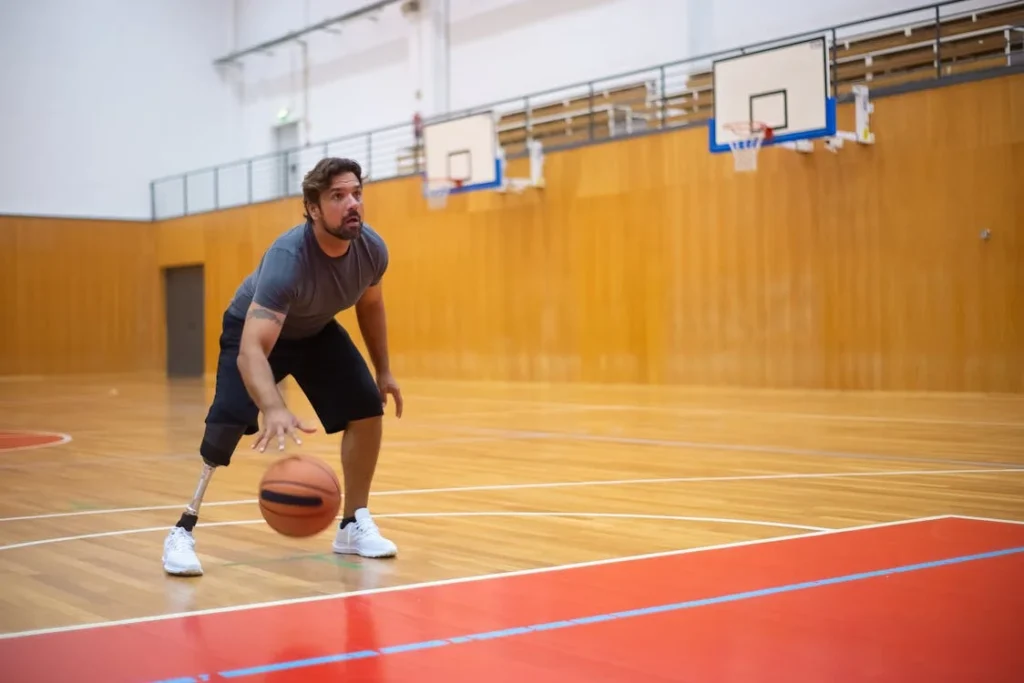
Why Strength Keeps You Moving Forward for Life
Prevents Injury and Long-Term Discomfort
Once you’ve been fitted and start using your prosthetic regularly, a new phase of your journey begins. But here’s something that surprises many people — just getting a prosthetic doesn’t mean everything clicks into place right away. It takes time, practice, and a lot of body awareness. This is where your strength work continues to pay off.
Without strong muscles and good posture, other parts of your body will start to compensate for the weakness. You might put more pressure on your sound limb, lean to one side, or twist your hips in small ways that eventually cause pain.
These habits may not be noticeable at first, but over time they can lead to joint problems, back pain, or even injuries that slow you down.
When your residual limb is strong and stable, you move with more balance and efficiency. You’re less likely to overuse your shoulders, knees, or hips. Your movements are smoother.
You avoid putting too much pressure on the prosthetic or the rest of your body — which means fewer injuries and a lot more comfort as the years go on.
Think of your strength like a long-term investment. The work you do in the beginning builds a safety net for your future.
Improves Comfort During Daily Activities
Wearing a prosthetic isn’t just about walking or lifting. It’s about living — doing the small things that fill your day. Getting dressed. Carrying a bag. Cooking. Sitting at a desk. Playing with your child. These are the moments where comfort really matters.
If your residual limb is weak or unstable, even simple activities can feel tiring or uncomfortable. The prosthetic may shift while sitting or feel too heavy while standing.
You may need to stop more often or adjust your position constantly. But when your muscles are conditioned, your body supports the prosthetic — rather than fighting it.
You’re able to go longer without discomfort. You need fewer breaks. You move more naturally, and that natural movement feels better all around. Strength supports not just big actions, but also the flow of your day.
Supports Greater Independence and Confidence
One of the most powerful outcomes of strengthening your residual limb is what it does for your independence. When you’re stronger, you rely less on others.
You can take longer walks, carry your own things, get out of chairs without help, and handle more of your own care. This kind of freedom is life-changing.
More than that, it builds confidence. You start to see yourself differently — not as someone recovering from limb loss, but as someone adapting, growing, and thriving. You begin to say “yes” to more things: a short trip, a job interview, a visit with friends, a new hobby.
And when challenges come up — because they always do — you face them with a stronger foundation. You’ve already proven to yourself that you can adapt. You’ve already seen the results of your hard work. That belief in yourself becomes one of your greatest tools.
Confidence, like strength, is built in small steps. It starts the first time you move your limb on your own. It grows when you walk across a room without help. It grows again when you go through a whole day and realize, I did this.
Makes Adjusting to Prosthetic Upgrades Easier
As you grow, your prosthetic needs may change. You may upgrade to a more advanced model, switch from a passive to an active device, or get adjustments as your limb changes shape over time. These transitions can be challenging if your body isn’t prepared.
But if you’ve kept up your strength, these transitions feel smoother. Your body adapts faster. You can test new features with ease, and you’re more aware of how small changes affect your movement.
That awareness gives you more control — not just over the device, but over your future with it.
You’re no longer just a patient. You’re a partner in the process. And that shift — from being helped, to helping yourself — is one of the most powerful parts of recovery.
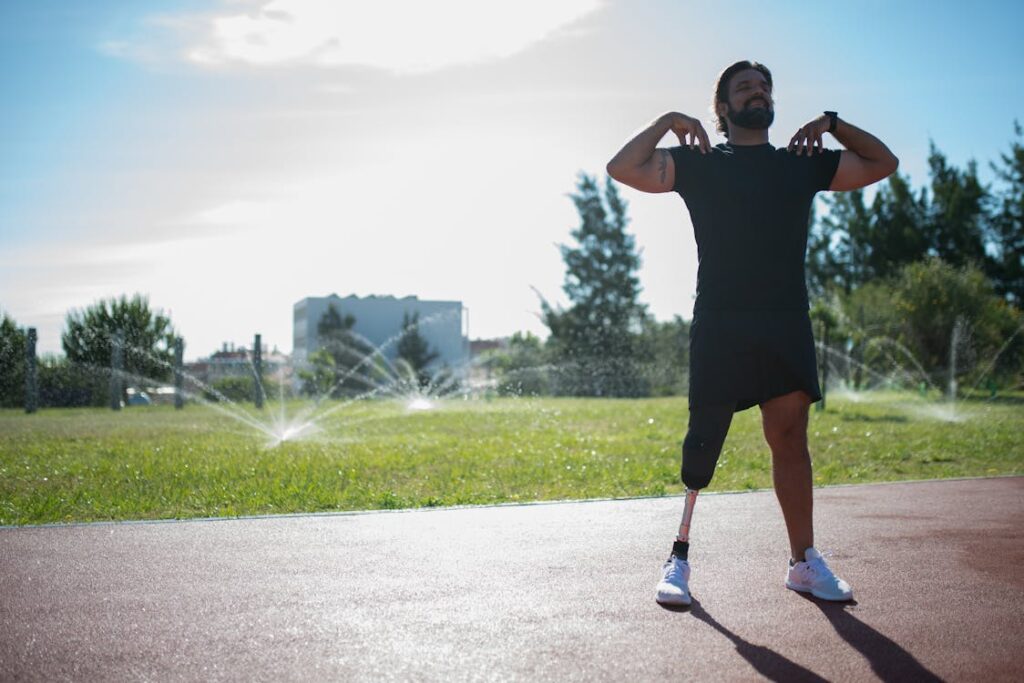
Rebuilding Identity Through Movement
The Emotional Side of Strength
When people think about recovery after amputation, they often imagine physical rehab — exercises, mobility, learning to walk or move again. But recovery is deeply emotional, too. The way we move is tied to who we are. It affects how we see ourselves and how we believe others see us.
Before amputation, your body may have been part of how you defined your identity — your stride, your handshake, the way you picked things up or carried yourself in a crowd. After surgery, there’s a pause.
A sense of disconnection. Strengthening your residual limb helps you rebuild physical function, yes — but it also gives you back a piece of that connection to self.
When you first start moving again, even if it’s just a tiny lift or muscle squeeze, it’s more than a physical action. It’s a signal: I’m still here. My body still listens. I still have control.
This moment is powerful. Many people describe it as a turning point — the moment they begin to see the limb not as a reminder of loss, but as something with purpose. Something that can grow stronger. Something that belongs to them, fully.
Movement as a Form of Self-Acceptance
Strengthening your limb often begins with hesitation. It might feel unfamiliar, or even frustrating. But over time, as you practice each day, something shifts.
You begin to accept the limb as part of your new body. The skin tone, the shape, the scars — they become part of your story, not just your wound.
This acceptance matters. Because when you stop resisting the change, your body responds better. Muscles activate with more precision. Balance returns more smoothly. You stop holding tension in other areas, and your movements become more fluid.
The limb you once viewed as “damaged” becomes a source of pride — not because it looks a certain way, but because you’ve worked with it, trained it, strengthened it. You’ve taken back ownership, and that changes everything.
Why This Connection Enhances Recovery
A strong emotional connection to your body improves motivation. When you believe your limb matters, you’re more likely to care for it, to move it, to protect it.
You become more tuned in to changes — like swelling, soreness, or skin irritation — and you respond early, which prevents bigger problems later.
This connection also reduces fear. The first time you stand with your prosthetic, it’s less about Can I do this? and more about Let’s see how this feels today. That shift in mindset — from fear to curiosity — builds resilience.
And perhaps most importantly, it helps redefine what strength means. Not just lifting weights or building muscle, but standing tall when things are uncertain. Showing up, day after day, for yourself.
Movement Can Be Healing Beyond the Physical
In many ways, movement becomes medicine — not just for your body, but for your heart and mind. Small movements give you progress. Progress gives you momentum. Momentum gives you hope.
You start looking forward to the day’s exercises not because they’re easy or exciting, but because they give you structure. They remind you that you’re not stuck — you’re in motion, moving through recovery, reclaiming control.
Over time, movement transforms from a task into a ritual. Something personal. Something that belongs to you. It becomes part of your identity again.
That’s why strengthening your residual limb isn’t just about physical function. It’s about emotional healing, self-expression, and rewriting the story you tell yourself when you look in the mirror.
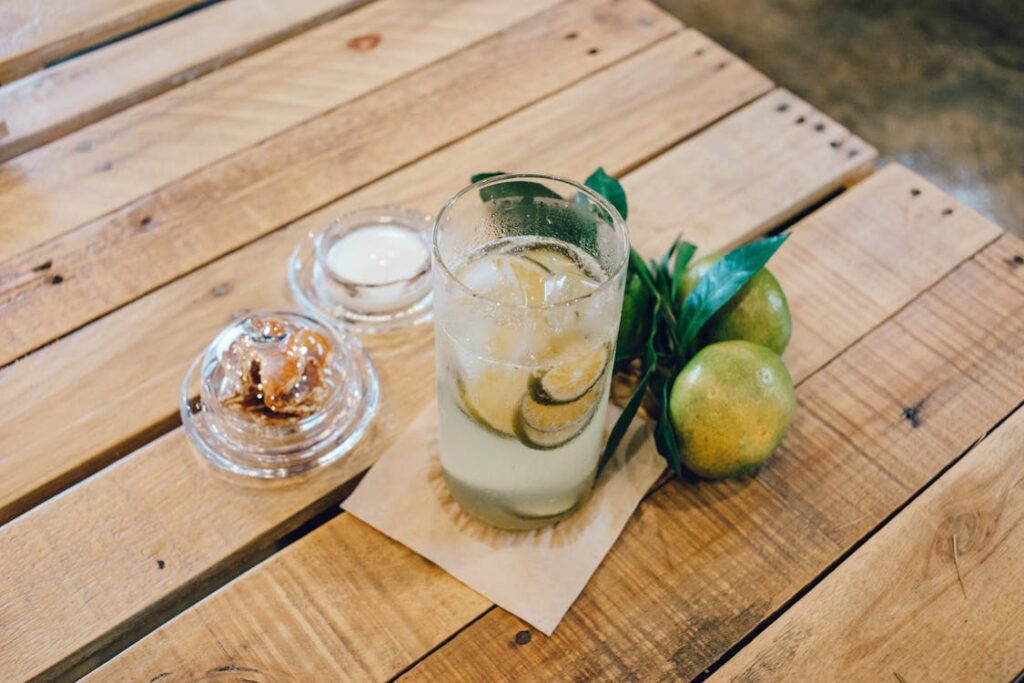
Fueling Strength: The Role of Nutrition and Hydration in Residual Limb Recovery
Why Food Matters More Than You Think
When we talk about getting stronger, we often focus on the physical work — movement, stretching, exercise. But what many people don’t realize is that what you eat and drink plays a powerful role in how your body recovers and builds strength, especially after an amputation.
After surgery, your body goes into high gear to repair tissues, manage inflammation, and create new pathways of movement. It needs building blocks — not just from exercise, but from your diet.
Without proper nutrition, muscle tissue breaks down faster, the skin heals slower, and energy levels crash, making therapy harder to maintain.
In fact, people who eat poorly during recovery often feel more fatigued, have weaker muscles, and are at higher risk of skin problems — all of which affect how their residual limb shapes up for prosthetic fitting.
The body can’t build muscle from movement alone. It needs the right raw materials — protein, vitamins, minerals, and water — to make that effort count.
Protein Is Essential for Muscle Repair and Growth
Your muscles are made of protein. After surgery and during strengthening, the tiny fibers inside your muscles break down a little with use, and then rebuild — stronger — as part of healing. But that rebuild can’t happen if your body doesn’t have enough protein.
This doesn’t mean eating massive amounts. It just means making sure every meal contains a good source of protein — like lentils, eggs, yogurt, tofu, or lean meats if you’re not vegetarian.
For those following a plant-based diet, combining grains and legumes (like rice and dal) can also offer complete proteins.
If you’re doing exercises to strengthen your residual limb, having protein in your diet helps that effort turn into real results. It keeps your muscles firm, supports your immune system, and helps your limb stay in better shape for the socket fitting.
Hydration Keeps Tissues Supple and Skin Healthy
Water might seem too simple to be important, but it plays a quiet, critical role in healing. After an amputation, your skin goes through many changes — it stretches, reshapes, and must tolerate pressure from bandaging and eventually the prosthetic socket.
If your body is dehydrated, your skin becomes dry and fragile, making it more prone to cracks or breakdown.
Hydration also helps your muscles stay more flexible and responsive. Muscles that are “dry” don’t contract and relax as well. This can increase soreness and reduce the quality of your movements.
You don’t need to overthink hydration. Just try to sip water throughout the day, especially after therapy sessions. Herbal teas, coconut water, or diluted fruit juices can also help — but water should be your main go-to.
Micronutrients Power the Details of Healing
While protein and water are the heavy lifters, vitamins and minerals are the support crew. They may not get all the attention, but they handle hundreds of tiny processes that keep your recovery on track.
For example:
- Vitamin C helps form collagen, which your body uses to repair skin and connective tissues.
- Zinc supports wound healing and immune health.
- Magnesium helps muscles relax and reduces cramping.
- Vitamin D supports bone health and improves muscle function — especially important if you’re spending less time outdoors.
These nutrients come from fruits, vegetables, whole grains, nuts, and seeds. Including a variety of colors in your meals is a simple way to make sure you’re getting what you need. And if your doctor suggests supplements, those can help too — especially if you have dietary restrictions.
When Nutrition Is Ignored, Progress Slows Down
Some people see strengthening as only a physical task — something that lives in the therapy room or the gym. But if your body doesn’t have fuel, even the best therapy plan will struggle to succeed.
Without enough nutrients:
- Muscles recover slower from exercise.
- Swelling takes longer to go down.
- Skin problems may delay prosthetic fitting.
- Energy levels drop, making it harder to stay consistent.
All of this can create a cycle where people feel stuck. They don’t see progress, so they lose motivation — even though the missing piece might just be nutrition.
That’s why a well-balanced diet isn’t just nice to have. It’s a part of therapy — as vital as stretching, lifting, or walking.
Conclusion
Strengthening your residual limb isn’t just about exercise — it’s about building a strong foundation for everything that comes next. From how your prosthetic fits to how you move, live, and feel, the work you do before fitting shapes your entire journey.
But strength doesn’t come from movement alone. It comes from care — physical, emotional, and even nutritional. It’s in every small action: a gentle lift, a sip of water, a well-balanced meal, a moment of stillness to breathe and believe.
This process takes time. It takes patience. But most of all, it takes trust — in your body’s ability to adapt and in your heart’s ability to keep going.
No matter where you are in your journey, know this: you’re not behind. You’re building something strong, steady, and truly yours.



